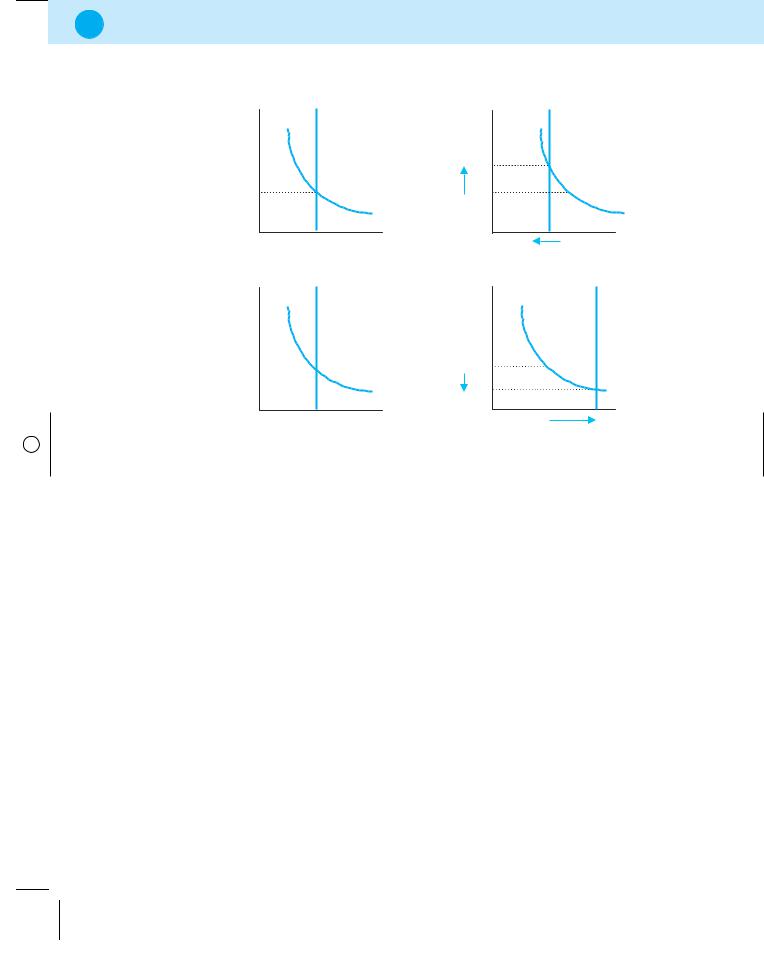
- •1.5.1 The Environment for Economic Decisions
- •2.3 Demand
- •2.4 Supply
- •2.5.1 Changes in Equilibrium
- •2.6.1 Price Ceiling
- •2.6.2 Price Floor
- •2.6.3 Problems of Price Ceilings and Floors
- •2.9.1 Labour Demand
- •2.9.2 Labour Supply: Individual Supply Decision
- •2.9.3 Equilibrium in the Labour Market
- •3.2.1 Consumption Goods
- •3.3.1 The Assumption of Rationality in Economics
- •3.4.1 The Law of Demand – Income and Substitution Effects
- •3.5.1 Consumer Surplus and Consumer Welfare
- •3.6.1 Price Elasticity of Demand
- •3.6.2 Applications of Elasticity Analysis
- •3.6.3 Other Elasticity Examples
- •3.7.1 The Attribute Model: Breakfast Cereals
- •4.3.1 Decisions of Firms and the Role of Time
- •4.3.2 Firm Revenue
- •4.3.3 Firm Output (Product): Marginal and Average Output
- •4.3.4 Firm Costs
- •4.3.5 Marginal and Average Costs
- •4.4.1 Profit Maximization, Normal Profit and Efficiency
- •4.4.2 Maximizing Profits Over the Short Run
- •4.8.1 Using Subsidies – An Example with International Trade
- •4.8.2 Environmental Taxes – Effects on Production
- •4.8.3 Tax Incidence
- •5.3.1 Explanations/Causes of Business Cycles
- •5.3.2 Implications for Business and Government
- •5.4.1 Other Measures of Economic Activity
- •5.4.2 Economic Activity: GNP, GDP and Income
- •5.5.1 The Price Level
- •5.5.2 Aggregate Demand
- •5.5.3 Aggregate Supply
- •5.5.4 Bringing AD and AS Together: The Short Run
- •5.7.1 Explaining Growing International Trade
- •5.7.2 Benefits and Costs of International Trade
- •5.8.1 Another Perspective on Economic Activity: The Economy as a Production Function
- •6.2.1 Competition as a Process
- •6.2.2 Entrepreneurship, Discovery and the Market Process
- •6.3.1 Perfect Competition
- •6.3.2 Monopoly
- •6.3.3 Perfect Competition vs. Monopoly
- •6.3.4 Monopolistic Competition
- •6.3.5 Oligopoly
- •6.5.1 Why Markets May Fail
- •6.5.2 Implications of Market Failure
- •6.6.1 Competition Spectrum
- •6.6.2 Structure, Conduct and Performance
- •6.6.3 Competition Policy
- •7.3.1 The Money Multiplier
- •7.5.1 Which Interest Rate?
- •7.5.2 Nominal and Real Interest Rates
- •7.7.1 Demand in the Foreign Exchange Market
- •7.7.2 Supply in the Foreign Exchange Market
- •7.7.3 Exchange Rate Determination
- •7.7.4 Causes of Changes in Exchange Rates
- •7.8.1 Investment in Bond Markets
- •7.8.2 Bonds, Inflation and Interest Rates
- •7.9.1 Difficulties in Targeting Money Supply
- •7.9.2 Alternative Targets
- •7.9.3 Taylor Rules and Economic Judgement
- •7.10.1 Considering the Euro
- •8.2.1 Labour Market Analysis: Types of Unemployment
- •8.2.2 Analysing Unemployment: Macro and Micro
- •8.2.3 Unemployment and the Recessionary Gap
- •8.2.4 The Costs of Unemployment
- •8.3.1 The Inflationary Gap
- •8.3.2 Trends in International Price Levels
- •8.3.3 Governments’ Contribution to Inflation
- •8.3.4 Anticipated and Unanticipated Inflation – the Costs
- •8.4.1 A Model Explaining the Natural Rate of Unemployment
- •8.4.2 Causes of Differences in Natural Rates of Unemployment
- •8.5.1 Employment Legislation
- •9.2.1 The Dependency Ratio
- •9.4.1 More on Savings
- •9.4.2 The Solow Model and Changes in Labour Input
- •9.4.3 The Solow Model and Changes in Technology
- •9.4.4 Explaining Growth: Labour, Capital and Technology
- •9.4.5 Conclusions from the Solow Model
- •9.4.6 Endogenous Growth

248 |
T H E E C O N O M I C |
S Y S T E M |
|
|
|
|
|
A |
|
B |
|
|
|
|
Interest |
Money supply |
Interest |
|
Money supply |
|
|
rate |
|
rate |
|
|
|
|
|
|
r^ |
|
|
Demand for |
|
|
Demand for total |
|
|
total |
|
|
|
|
|
|
||
|
r* |
balances |
r* |
|
|
balances |
|
|
Q |
|
|
|
Q |
|
C |
|
D |
|
|
|
|
Interest |
Money supply |
Interest |
Demand for |
||
|
rate |
rate |
||||
|
|
total |
|
Money |
||
|
|
|
|
|
||
|
|
|
|
balances |
supply |
|
|
Demand for total |
r* |
r* |
balances |
|
|
|
r+ |
|
Q |
Q |
F I G U R E 7 . 3 M O N E Y M A R K E T : D E M A N D A N D S U P P L Y
The interest rate must decline when the supply expands because, as shown in Figure 7.3 panel D, at the original interest rate of r the expanded money supply is greater than demand at that price. The market only clears if the interest rate drops to bring demand and supply together.
7.5.1WHICH INTEREST RATE?
Figure 7.3 simplifies the process by which the interest rate is determined because there is more than one interest rate determined in an economy at any time. For example, one interest rate is charged for mortgages. Mortgages are a feature of the capital rather than the money market since they are long-term debts – debts shorter than one year are features of the money market. Another interest rate is earned on deposits held by savers, while another is earned on deposits held for one month, or three months, and so on. Two main elements help to explain differences in interest rates:
•Loan term: loan repayment periods vary in time; some are short like the overnight borrowing that some banks engage in with their central bank, others

M O N E Y A N D F I N A N C I A L M A R K E T S I N T H E E C O N O M I C S Y S T E M |
249 |
like mortgages are for up to 30 or 35 years. Generally speaking long-term rates are higher than short-term rates, although mortgages do enjoy lower rates than other types of loan
•Risk associated with borrower : not all loans are repaid as individuals go bankrupt and businesses shut down. Lenders are free to take into account the probability of default when providing loans and higher interest rates are associated with riskier loans.
All of the above interest rates tend to change together following a similar trend, however, which means the simplifying assumption that there is only one rate can be used.
7.5.2NOMINAL AND REAL INTEREST RATES
Economists are interested in real variables because this allows for comparisons to be made in terms of purchasing power over time. Interest rates, like any prices, can be quoted in real or nominal terms. The nominal interest rate on deposit accounts, for example, is the rate quoted by banks – say 0.75% – meaning that you could earn 0.75% interest on any deposits held for one year.
When nominal interest rates change, individuals’ incentives to save or borrow are affected. An increase in the nominal rate raises returns for savers but makes borrowing more expensive while a cut in the nominal rate has the opposite effects. Since savings create the deposits that banks use for creating money via providing loans, the amount of savings in an economy is of crucial importance for the real interest rate, which takes purchasing power into account.
The real interest rate (r) is computed as the difference between the nominal interest rate and the rate of inflation.
r = i − π
where i denotes the nominal rate and π is the rate of inflation.
If the annual rate of inflation is 4% while the nominal interest rate is 0.75%, then the real interest rate is −3.25%. This means that any deposits held in a bank will buy 3.25% fewer goods at the end of a year as the purchasing power of money has declined – prices rose faster than the rate of return on money. The real interest rate is a positive number once the inflation rate is less than the nominal rate of interest. If real interest rates are expected to be negative, it may be logical for consumers to make purchases today rather than hold onto money that will buy

250 |
T H E E C O N O M I C S Y S T E M |
fewer goods in the future so savings might be relatively low. Hence, via individuals’ consumption behaviour, nominal and real interest rate effects have implications for aggregate demand.
With negative real interest rates, borrowers’ debts would decline in real terms so people might be happy to borrow knowing that without making any repayments the real value of their borrowings will decline! In this case, consumption and aggregate demand are also affected. There is evidence that, when real interest rates are negative and large, consumers prefer to spend and can even cause asset prices and/or property prices to rise rapidly if supply cannot expand sufficiently quickly to meet demand. Furthermore, if share prices rise rapidly as well due to increased demand for such financial assets this can cause further increases in consumer spending and may even lead to inflation (if aggregate demand shifts rightwards intersecting aggregate supply at a new equilibrium point with higher output and a higher price level).
Financial or property bubbles are often associated with negative real interest rates as people are willing to invest or speculate on assets with an amount of certainty that because real returns on assets are falling, their losses will be partially ‘protected’. In markets where bubbles exist, there tends to be an over-enthusiasm on the part of investors who believe that increases in asset values will continue into the future and so they are increasingly willing to invest, pushing up the price of the asset and as long as people expect that asset values will continue to rise, the bubble gets bigger and bigger and may eventually burst, as in the case of the technology stock market in 2000. Alan Greenspan the Chairman of the Federal Reserve famously asked in a speech in late 1996: ‘How do we know when irrational exuberance has unduly escalated asset values, which then become subject to unexpected and prolonged contractions as they have in Japan over the past decade?’
His concern was in relation to monetary policy and his fears were that there could be effects that would impact ‘the real economy, its production, jobs, and price stability’. Clearly expectations about the future play a key part in bubbles but as Mr Greenspan pointed out can affect the ‘real’ economy in adverse ways if the bubbles burst.
For firms thinking about making investments and who need to finance those investments via bank loans, the nominal and real interest rates also play a central role in their decisions. Their strategies regarding buying and selling shares in both their own and other companies will also be affected by the interest rates. Ceteris paribus, firms will be most likely to borrow when nominal interest rates are low and this is why you often hear business analysts arguing that cuts in interest rates by the Federal Reserve or the European Central Bank are needed to ‘stimulate

M O N E Y A N D F I N A N C I A L M A R K E T S I N T H E E C O N O M I C S Y S T E M |
251 |
business activity’. If interest rate cuts lead to consumers buying more, then both the investment and consumption effects in the economy would boost economic activity via a shift in the aggregate demand function.
In May 2003, commentators correctly predicted a cut in the ECB’s interest rate from 2.5% to 2% given the poor economic growth in the French and German markets and the fact that inflation of 1.9% was below the target rate of 2% for the euro zone. In fact some analysts were predicting falling prices (deflation) in the German market and argued one way to attempt to avoid this was to cut interest rates significantly by half a percentage point to 2.0% stimulating consumption (and thereby aggregate demand) and reducing any downward pressure on the price level. Such a drop in the interest rate to 2.0% when inflation was at 1.9% would imply a real interest rate of 0.01%.
Finally, in relation to Figure 7.3, the real interest rate is determined if real money supply and real money demand are considered, while if nominal supply and demand are of interest, the nominal interest rate is determined.
7 . 6 Q U A N T I T Y T H E O R Y O F M O N E Y A N D E X P L A I N I N G I N F L A T I O N
From the motives for holding money considered earlier, we know that people demand money in order to make transactions and logically the more money needed for expected transactions, the more money people will want to hold.
Another way of stating this is via the quantity equation:
M × V = P × Y
where M denotes the nominal money supply in an economy, V denotes velocity of money, P denotes the average price level, Y denotes the level of real economic activity and hence P × Y is the nominal value of economic activity (i.e. income or output).
The velocity term is a measure of how often an average unit of money is used in a period of time. If £100bn-worth of nominal output is produced in an economy

252 |
T H E E C O N O M I C S Y S T E M |
in a year and the stock of money in that economy is £10bn, then the velocity term is equal to 10, implying that each unit of money (£1) is used ten times per year appearing as ten separate transactions in the circular flow.
If any of the terms in this equation change, there is an impact on one or more of the other variables so if the quantity of money falls and the velocity is unchanged, either the price level or the level of activity must fall.
Another way of expressing the quantity equation is in terms of velocity where:
V = P × Y
M
which defines the velocity of money as the ratio of nominal income to the quantity of money in the economy. In practice the velocity of money does not change hugely over time and it can be assumed that V is constant. If this assumption is made the quantity equation becomes a relationship between the quantity of money and the nominal level of income in an economy whereby any change in the amount of money in an economy would lead to a similar change in nominal income: when V is constant, if the quantity of money increases by 10%, so too will the nominal value of income.
To see what this implies (assuming still that V is constant) take the case where an economy produces £100bn of real output in a given year and has an average price level, P , so nominal output is given by P × £100bn. The same economy has £10bn of money. Any change in the quantity of money must lead to a change in the price level in the economy because the real output is the actual quantity of output produced (if this causes you problems think of real output as 100 ‘bags’ or ‘bales’ of output!). If the money supply rises by 20% to £12bn, the effects are felt through P , which rises also by 20% as the ‘bags’ of output produced are 100, whatever happens.
A change in P , the aggregate price level, is caused by a change in money supply. An increase in the price level is called inflation. Hence, inflation is caused by increasing the money supply.
By implication, central banks – through their setting of money supply – can affect the rate of inflation. Analyses of the correlation between inflation rates and money supply growth (according to the M1 definition) reveal a strong positive relationship over the long run.
In order for the money supply to be the sole determinant of inflation, we assumed no change in real output. This would be true for an economy operating in the long run at its potential output level with all resources fully employed. From our previous analysis of economic activity, however, we know that real output tends to be cyclical

M O N E Y A N D F I N A N C I A L M A R K E T S I N T H E E C O N O M I C S Y S T E M |
253 |
in the short run. We know too that there is a marked upward trend in real output in developed countries over time.
Hence, a change in the money supply results in the same proportional change in P , the aggregate price level, if we treat real output as constant.
We can go one step further and consider what that would imply for the demand for money. If real output (income) rises by 5%, the demand for money should do so too to buy the extra output/to spend the extra income. If money supply grows by 8% then prices need rise only by 3% because 5% of the extra money supply is needed due to the growth in economic activity. By implication, long-run inflation should equal the rate of growth of the money supply minus the real rate of growth in economic activity.
Inflation = rate of money supply growth − rate of real output growth e.g. inflation = 8% − 5% = 3%
7.6.1INFLATION EXPECTATIONS, INTEREST RATES AND DECISION-MAKING
If I lodge money into a deposit account preferring to save rather than buy consumption goods, I expect to earn some interest, depending on the deposit account I select. I know that if there is a change in the interest rate announced by the central bank, that change, or at least a portion of it, will be passed on to me by my bank. This means that I cannot be sure of the nominal return I will earn on my account. Since I also do not know what inflation will be in the future, I cannot compute the real interest rate with certainty. I can, however, make my best guess at the inflation rate and hence the real interest rate.
Similarly for borrowers taking out loans where the nominal interest rate varies depending on what the central bank dictates and the real repayments can be guessed with varying amounts of accuracy depending on how close the economic outcome is compared to the decision-maker’s forecast. In decision-making when we base our choices on our best guesses of what we expect the inflation rate to be, we use an ex-ante real interest rate. This is our best guess given available information about a future occurrence. The actual real interest rate that we can measure once we know what the inflation and nominal interest rates are is called the ex-post real interest rate.

254 |
T H E E C O N O M I C S Y S T E M |
The ex-ante real interest rate is r = i − π e where π e is expected inflation. Rearranging this expression, the nominal interest rate i = r + π e. (This is
known as the Fisher equation and is explained below.)
The ex-post real interest rate is r = i − π where π is actual inflation.
Expectations regarding future inflation are central to economic decision-making when current and future flows of income must be considered. This has implications for our analysis of the role of a central bank in setting the interest rate via its money supply. Consider the case where a central bank conducts an open-market operation by increasing the money supply, i.e. it buys bonds and pays money in return, which it takes from its reserves. Increased money supply implies excess supply for money at the original interest rate and the money market can clear only if the nominal interest rate falls. This may not always happen.
If money market analysts interpret the increase in money supply as a policy direction of the central bank to indicate that there will be rise in the rate of growth of the money supply (not just an increase in its level), they may predict further increases in money supply in the future. This would mean that the expected rate of inflation would rise, from the relationship described as:
% inflation = % money supply growth − % real output growth.
From the Fisher equation, a rise in the expected rate of inflation would put upward pressure on the nominal interest rate since it depends on the real interest rate and expected inflation. Fisher showed that if expected inflation increases by 1% then the nominal interest rate also rises by the same amount.
If the money market analysts got it wrong in predicting faster growth of the money supply, over time people would see that the expectations of higher inflation were mistaken and the expectation would disappear. In that case the nominal interest rate would certainly fall.
A central bank has only limited control of the interest rate in the short run. Changes in inflation expectations can change the outcome predicted by the money demand and supply model.
If a central bank really wants to lower interest rates, it should lower inflation or, more specifically, inflationary expectations. It can attempt to do this by reducing the rate of growth in money supply and by being a credible institution. Credibility in its policies basically implies that the central bank means what it says and if it sets a policy target of 2% inflation (for example) it will stick to this target. This

M O N E Y A N D F I N A N C I A L M A R K E T S I N T H E E C O N O M I C S Y S T E M |
255 |
credibility of policy generates certainty for consumers and firms facilitating their economic decisions.
The credibility of central banks’ policies is tied to their independence. By independence we mean the extent to which the central bank is free to set its own targets for inflation and interest rates without political interference from a government, Minister for Finance, or Chancellor of the Exchequer. Studies have shown that economies with the most independent central banks have lower inflation performance and less variable inflation (DeLong and Summers, 1993). The countries did not appear to have any higher unemployment, lower real income growth or larger short-run fluctuations in real output. In order to establish credibility, it appears central banks have to prove themselves as sticking to their word – if they set an inflation target then the policy is credible if they have managed to successfully stick to previously declared targets for inflation. Central banks are often judged on their ability not only in terms of inflation but in terms of maintaining a stable value for their currency, which is addressed next.
7 . 7 T H E F O R E I G N E X C H A N G E M A R K E T
The price of a currency (in terms of other currencies) depends on demand for the currency and supply of that currency. The demand for euros on the foreign exchange market is called a derived demand, derived from the demand for goods or financial assets. Holders of other currencies – US dollars, for example – purchase euros in order to pay for European goods and services or European financial assets, e.g. shares, government bonds and property.
The price of one currency in terms of another is called an exchange rate.
When exchange rates change currencies either appreciate or depreciate.
An appreciation of the euro occurs when £1 buys more foreign currency today than it did yesterday (when it costs more in terms of foreign currency to buy £1). A depreciation of the euro occurs when £1 buys less foreign currency today compared to yesterday (when it costs less in terms of foreign currency to buy £1).
Exchange rates are considerably more volatile than most prices, as you will know if you’ve ever had to buy foreign exchange when the price varies day-to-day if you buy from a bank or in real time as currencies are traded on international money markets. On 9 June 2003, ¤100 would have bought almost $118 whereas five months
